- Books Name
- ACME SMART COACHING Biology Book
- Publication
- ACME SMART PUBLICATION
- Course
- CBSE Class 11
- Subject
- Biology
TAXONOMIC CATEGORIES
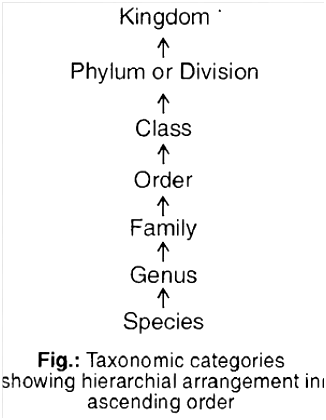
Classification is not a single step process. It involves hierarchy of steps in which each step represents a rank or category.
The category is a part of overall taxonomic arrangement. All categories together make taxonomic hierarchy.
Each category is also termed as a unit of classification. It represents a rank and is commonly called as taxon.
The taxon must be recognisable and order should belong to a category.
Taxonomic hierarchy is a series of different ranks placed in ascending or descending order.
It was Linnaeus who for the first time introduced five categories in the taxonomic hierarchy, viz., class, order, genus, species and variety.
Later on three more categories, viz., kingdom, division or phylum and family were added.
Variety was Species discarded to make a hierarchy of seven obligate categories.
Taxonomic categories kingdom -division (in plants) or phylum (in animals) -class -order -family -genus -species. (descending order)
Higher the category, higher is the number of organisms in it. Higher the category, fewer will be the number of common characters and greater is the difficulty of determining the relationship to other taxa at the same level. Hence, the problem of classification becomes more complex.
Taxonomic categories and hierarchy can be illustrated by an example. Insects represent a group of organisms sharing common features like three pairs of jointed legs.
It means insects are recognisable concrete objects which can be classified, and thus were given a rank or category.
Similarly, mammals represent animals with external ears, body hairs, mammary glands etc. Dog, mammals, animals are all taxa but of different categories.
Taxon dog, mammals and animals represent categories like species, class and kingdom respectively.
Species:
Term given by John Ray. It is lowest category of classification. It is a group of closely related individuals with similar morphological, anatomical, biochemical and cytological characters.
It is a group of naturally interbreeding population with the ability to produce fertile offsprings.
Individuals of a species share common gene pool.
It is reproductively isolated, thus genetically closed system.
e.g, Pisum sativum – Pea
Mangifera indica – Mango
Solanum tuberosum – Potato
Panthera leo – Lion
Homo sapiens – Human being
In these, sativum, indica, tuberosum, leo, sapiens represent the specific epithet, while Pisum, Mangifera, Solanum, Panthera and Homo represent genus.
Genus:
Genus is a group of related species. Species has more characters in common in comparison to species of other genera.
e.g., Potato, (Solanum tuberosum), makoi (S. nigrum) and brinjal (S. melongena) are three different species belonging to same genus Solanum.
Lion, leopard and tiger with several common features belong to the same genus Panthera.
Family:
It is a group of related genera with still less number of similarities as compared to genus and species. Families are characterised on the basis of both vegetative and reproductive features of plants.
For example, four related genera Solanum, Petunia, Datura and Atropa belong to the family Solanaceae. Genus Panthera and Felis (cat) are put together in family Felidae.
Order:
It is a group of related families which exhibit a few similar characters. The similar characters are less in number as compared to different genera included in a family.
For example, plant families like Convolvulaceae and Solanaceae are included in order Polymoniales mainly based on floral characters.
In animals, order carnivora includes families like Felidae (cat) and Canidae (dog).
Class:
It is a group of related orders.
For example , plants order like Sapindales (mango) and Polymoniales are included in Class -Dicotyledonae, Order -Volvocales (Volvox) and Conjugales (Spirogyra) are included in Class -Chlorophyceae (green algae).In animals, order Primata (man, monkey) and Carnivora (cat, dog) are included in class -Mammalia.
Phylum/Division :
It is a group of related classes.
The phylum Chordata of animals contains not only the class mammalia but also aves (birds), reptilia (reptiles) amphibia (amphibians) and osteichthyes (fishes).
In case of plants, classes with few similar characters like dicots and monocots constitute division -Angiospermae.
The category phylum is used in animalia while division is used in plantae.
Kingdom:
It is highest category in hierarchy with related phylums or divisions.
Kingdom animalia includes all animals belonging to different phyla. Kingdom Plantae includes all plants of various divisions.
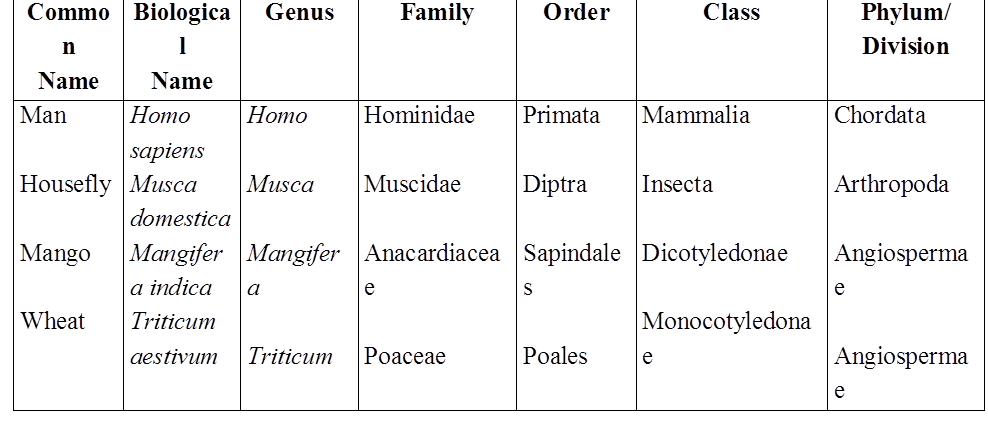
Concept of Species :
Biological concept of species (was given by Ernst Mayr) : Species is the fundamental unit of classification. A species is a group of organisms (i) which are closely related (structurally and functionally) sharing a common gene pool (ii) which can interbreed freely in nature and produce fertile offspring in a natural environment. This concept of species is based upon reproductive isolation and called biological concept.
Some important interspecific hybrids (exception of biological concept of species)
(i) Sterile Hybrid (under natural conditions)
Mule = Between male donkey and female horse (Mare)
Hinny = Between male horse (Stal'lion) and female donkey
(ii) Fertile Hybrid (under captive conditions)
Tigon = Between male tiger and female lion
Liger = Between male lion and female tiger
Types of Species :
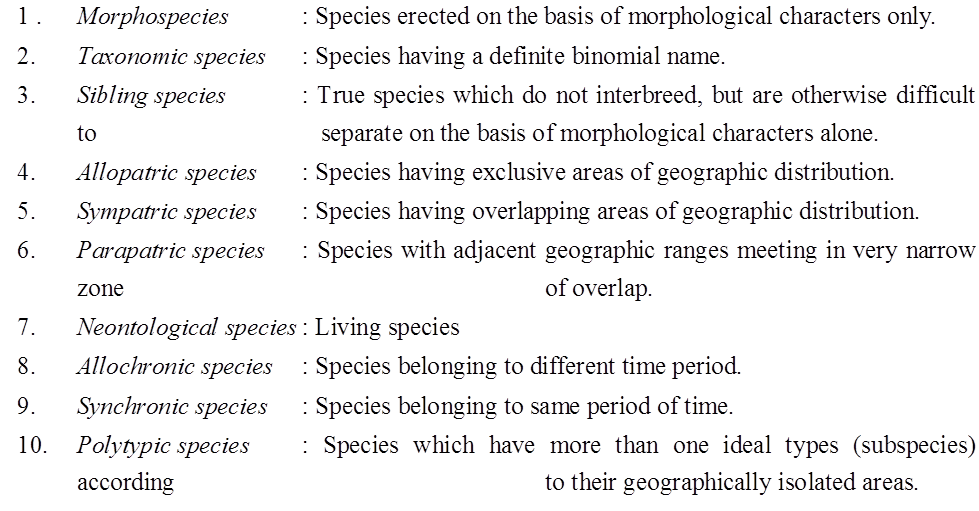
Concept Builder
In accordance with International Code of Botanical Nomenclature, the names of different categories must end in the standard endings (suffixes) given below :
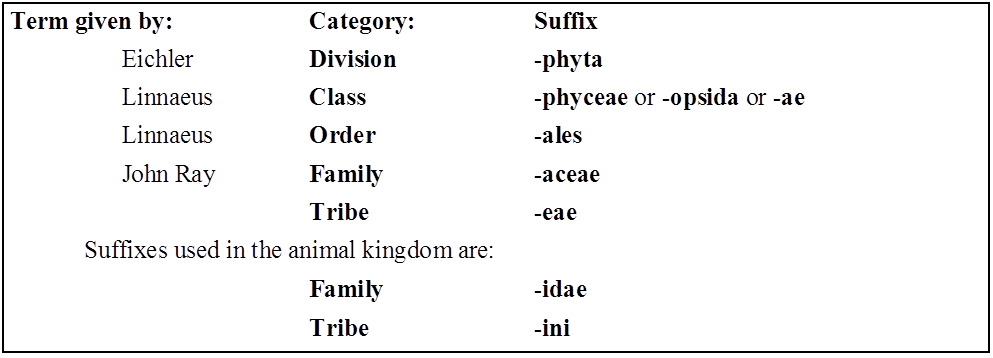
Tournefort gave the term genus and John Ray gave the term species
(b) Names of some families are changed according to ICBN rules for suffixes.
Old Name New Name
Palmae Arecaceae
Graminae Poaceae
Leguminosae Fabaceae
Compositae Asteraceae
Cruciferae Brassicaceae
Umbelliferae Apiaceae
Labiatae Lamiaceae
Guttiferae Clusiaceae
(c) Tribe is an intermediate category between sub-family and genus.
(d) In asexually reproducing organisms, physical resemblances and differences are used for delimiting species.
(e) Basic function of biological classification :
- (a) Recognition and description of species.
- (b) Grouping the species on the basis of similarities and relationship.
- (c) To establish evolutionary relationship amongst different organisms.
(f) The genera which have more than one specific epithets, are known as polytypic.
Lion – Panthera leo
Leopard – Panthera pardus
Tiger – Panthera tigris
(g) There are 7 obligate categories and about 21 intermediate categories. Prefixes: sub-and super-used for intermediate categories.
(h) Species name is given on the basis of some characters or habit, colour and distribution, e.g., niger (black), alba (white), tuberosum (tuber).
(i) Taxon is a group of real organisms which is assigned for any category. It is the unit of classification for any rank. Term taxon was introduced by ICBN in 1956 and defined by Mayr (1964).
(j) Category is an abstract term and represents only rank or level in a hierarchy and does not represent the living organisms. Example: Reptile is taxon but reptilia is category.
(k) Typological concept of Species
It was proposed by “Aristotle” and “Plato”. According to this concept, “There is a definite type or pattern of characters are present in the each species and all the members of species shows maximum resemblance with this pattern”. The species in which one fixed pattern of characters is present are called as monotypic species. e.g., Bacteria, Blue green algae if more than one type of pattern of characters are present. These are called “Polytypic species” or “Macrospecies”. e.g., Brassica oleracea Cauliflower, Cabbage, Knol-Knol.
Type of Polytypic Species :
Biotype : Members of same species inhabiting similar environment and having some genetic variations are known as biotypes. Variations found in these members are permanent. These members can not interbreed among themselves. e.g. Cauliflower, Cabbage, Knol-Khol are three biotypes of one species
Ecotypes : Members of same species inhabiting different environment and having some genetic variations are known as ecotypes. Variations are permanent. These members can interbreed among themselves but due to geographical barrier they can not interbreed.
e.g., Crow (Corvus splendense) found in different regions are ecotype of one species
Corvus splendense splendense - Indian crow
Corvus splendense insolense - Myanmar crow
Corvus splendense protegatus - Srilankan crow
Ecospecies : It contains one or more ecotype which although interfertile (capable of interbreeding), but do not produce viable offsprings due to some natural interruption (mountain, ocean etc).
Ecads or Ecophenes : Members of same species having some non genetic variation due to environment. These variations are temporary.
e.g.,

Taxonomic Categories
Classification is not a one-step procedure, but rather a series of stages, each representing a rank or category. The category is called a taxonomic category because it is a part of the larger taxonomic arrangement, and all categories combined make up the taxonomic hierarchy. Each category, also known as a classification unit, indicates a rank and is frequently referred to as a taxon (plural taxa). A taxonomic category is a category that is part of a taxonomic arrangement, and all categories combined make up the taxonomic hierarchy. Thus, organisms are divided into kingdoms, phyla or divisions, classes, orders, families, genera, and species.
Insects are a group of organisms with three pairs of jointed legs and other characteristics in common. It indicates that insects are recognizable concrete objects that can be categorized and so have a rank or category assigned to them. The categories are represented by groups of people. Rank is also indicated by category. Each rank, or taxon, is a classification unit. These taxonomic groups/categories are biological entities in their own right, not just morphological aggregations.
The establishment of common categories such as kingdom, phylum or division (for plants), class, order, family, genus, and species have resulted from taxonomic investigations of all known organisms. Species is the lowest level of classification for all organisms, including those in the plant and animal kingdoms. The knowledge of characteristics of an individual or group of organisms is required to categorize an organism into distinct categories. This aids in the identification of similarities and differences between individuals of the same species as well as individuals of different species.
Let us take a detailed look at different taxonomic categories:
(A)Species: A species is a group of individual beings that share fundamental characteristics. Based on morphological features, one species is separated from other closely related species. Mangiferaindica, Solanum tuberosum (potato), and Pantheraleo are just a few examples (lion). The first three words, Mangifera, Solanum, and Panthera, are genera and denote a higher level of taxon or category, while the first three words, indica, tuberosum, and leo, are specific epithets. Each genus may have one or more specific epithets that refer to various creatures that share morphological characteristics. Panthera, for example, has the specific epithet tigris, and Solanum comprises species such as nigrum and melongena. Humans are members of the species sapiens, which is part of the genus Homo.As a result, the scientific designation for a human being is Homo sapiens. Species is regarded as the least inclusive and highly specific category of the taxonomic hierarchy.
(B) Genus: A genus is a collection of related species that share more characteristics than those from other genera. Genera can be defined as groups of closely related species. Potato and brinjal, for example, are two separate species that both belong to the Solanum genus. Panthera species include the lion (Pantheraleo), leopard (Pantherapardus), and tiger (Pantheratigris), all of which share several characteristics. This genus is distinct from the Felis genus, which includes cats.
(C) Family:In comparison to genus and species, a family consists of a set of related genera with fewer similarities. In plants, vegetative and reproductive characteristics are used to classify them into families. Solanum, Petunia, and Datura are three separate genera of plants that belong to the Solanaceae family. The genus Panthera, which includes the lion, tiger, and leopard, is placed in the family Felidae with the genus Felis (cats). Similarly, if you compare and contrast the characteristics of a cat and a dog, you would notice some parallels and variances. Felidae and Canidae are the two different families that they belong to.
(D) Order:Species, genus, and family are all based on a set of comparable characteristics. The aggregates of characters are used to identify the order and other higher taxonomic groups. The group of families that have a few similar characteristics is called order, which is a higher category. When compared to the different genera in a family, there are fewer comparable characters. Plant groups such as Convolvulaceae and Solanaceae are classified as Polymoniales based on their floral characteristics. Carnivora is an animal order that includes families like Felidae and Canidae.
(E) Class: A class is a taxonomic rank (a taxon) that contains species with similar characteristics; it is further divided into one or more orders. A class is a major taxonomic rank below the phylum (or division) and above the order in the biological categorization of life. This category includes orders that are related. Order Primata, which includes monkeys, gorillas, and gibbons, is placed in class Mammalia alongside order Carnivora, which includes tigers, cats, and dogs. Other orders also exist in the Mammalia class.
(F) Phylum/Division:A phylum is a classification or taxonomic rank that falls between kingdom and class. The Phylum is the next higher classification, which includes animals such as fish, amphibians, reptiles, birds, and mammals. All of these are classified as members of the phylum Chordata because they share characteristics such as the presence of a notochord and a dorsal hollow neural system. Classes with a few comparable features in plants are given to a higher category called Division.
In biological classification, the division is a taxonomic rank that is employed differently in zoology and botany. The division is a level similar to a phylum in botany and mycology. The term division is used in zoology to refer to an optional rank that is subordinate to the infraclass and superordinate to the cohort.
(G) Kingdom:In the classification system of animals, all animals belonging to distinct phyla are placed in the top category, Kingdom Animalia. The Kingdom Plantae, on the other hand, is unique in that it includes all plants of diverse divisions. These two groups are today referred to as the animal and plant kingdoms.
(H) Domain:A domain is the largest of all groupings in the classification of life in biology. At this level, the Archaea domain, Bacteria domain, and Eukarya domain are the three agreed-upon categories. The domain is considered to be the most inclusive category of the hierarchy.
The amount of shared features decreases as we progress from species to kingdom. The lower the taxon, the more features the members of the taxon share. The more difficult it is to determine a taxon's relationship to other taxa at the same level, the higher the category. As a result, the classification problem gets more complicated. Therefore, the taxonomists have also created sub-categories in the hierarchy to make the placement of distinct taxa more sound and scientific.
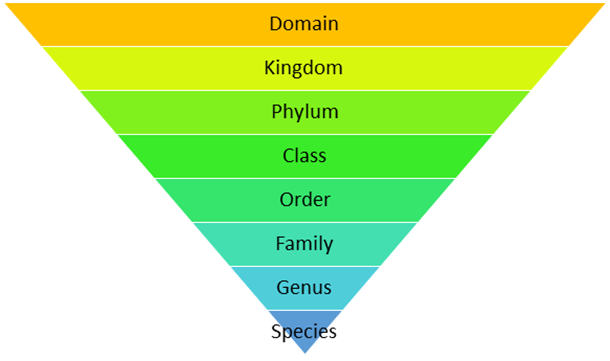

Taxonomy
Taxonomy Definition
Taxonomy is the branch of biology that classifies all living things. It was developed by the Swedish botanist Carolus Linnaeus, who lived during the 18th Century, and his system of classification is still used today. Linnaeus invented binomial nomenclature, the system of giving each type of organism a genus and species name. The Father of taxonomy was Carolus Linnaeus. He also developed a classification system called the taxonomic hierarchy, which today has eight ranks from general to specific: domain, kingdom, phylum, class, order, family, genus, and species.
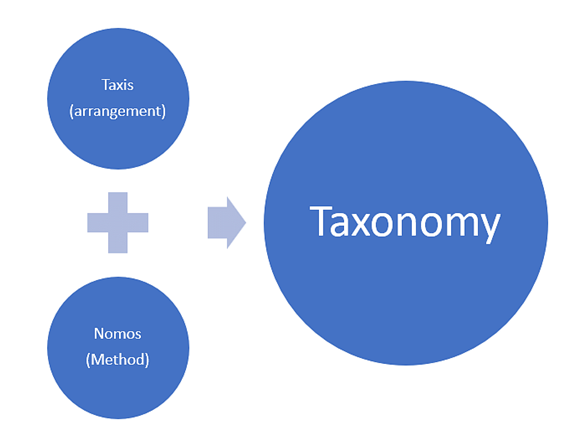
The Taxonomic Hierarchy
A taxon (plural: taxa) is a group of organisms that are classified as a unit. This can be specific or general. The hierarchy has two categories i.e., obligate and intermediate. Obligate is the one that is followed strictly and ranges from kingdom to species. Intermediate is not observed strictly and they. Also, they are added to the obligate lists like subdivision, superfamily, superclass, suborder, subspecies etc.
The following is a brief description of the taxonomic ranks of the taxonomic hierarchy.
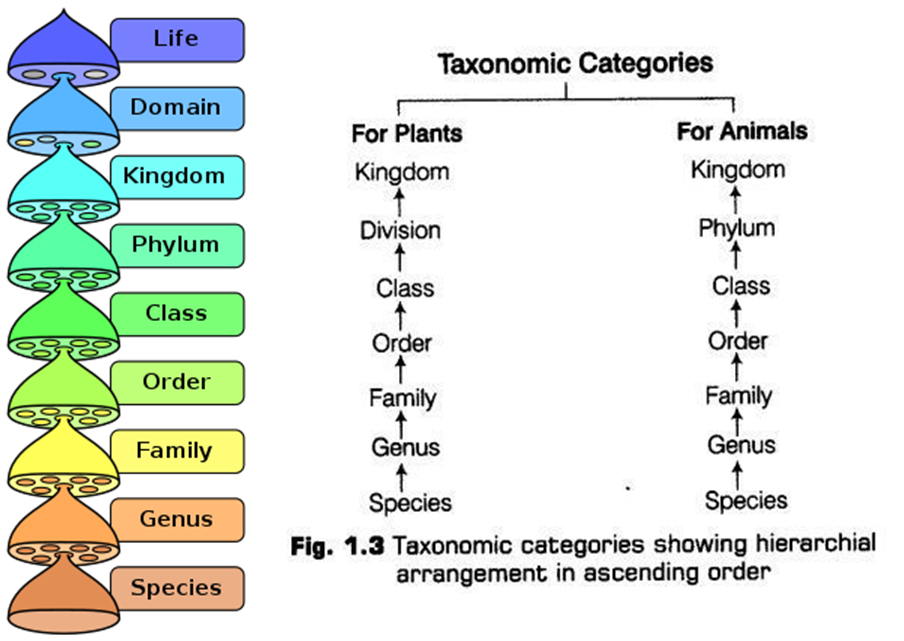
Domain
A domain is the highest (most general) rank of organisms. Linnaeus did invent some of the taxonomic ranks, but he did not invent the domain rank, which is relatively new. The term domain wasn’t used until 1990, over 250 years after Linnaeus developed his classification system in 1735.
The three-domain system of Carl Woese, introduced in 1990, with top-level groupings of Archaea, Bacteria, and Eukaryota domains.
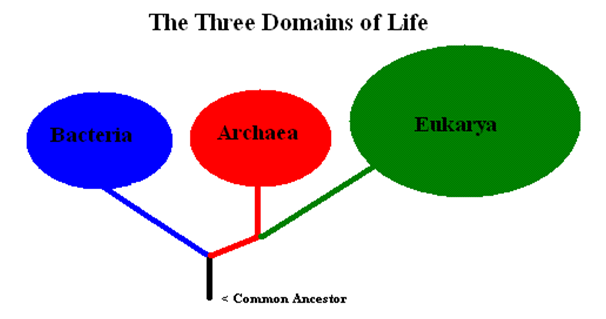
Kingdom
Before domains were introduced, the kingdom was the highest taxonomic rank. In the past, the different kingdoms were Animalia, Plantae, Fungi, Protista, Archaea, and Bacteria (Archaea and Bacteria were sometimes grouped into one kingdom, Monera)
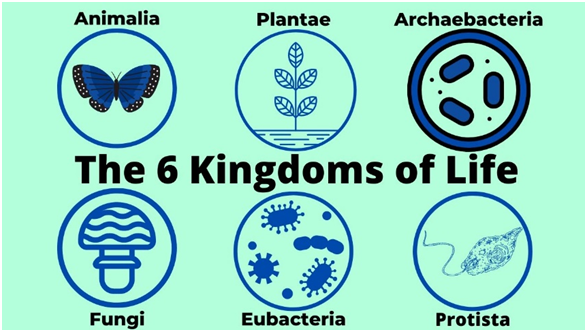
Phylum
Phylum (plural: phyla) is the next rank after kingdom; it is more specific than kingdom but less specific than class. There are 35 phyla in the kingdom Animalia, including Chordata (all organisms with a dorsal nerve cord), Porifera (sponges), and Arthropoda (arthropods).
Class
Class was the most general rank proposed by Linnaeus; phyla were not introduced until the 19th Century. There are 108 different classes in the kingdom Animalia, including Mammalia (mammals), Aves (birds), and Reptilia (reptiles), among many others.
Order
Order is more specific than class. Some of Linnaeus’ orders are still used today, such as Lepidoptera (the order of butterflies and moths). There are between 19-26 orders of Mammalia, depending on how organisms are classified—sources differ.
Genus
Genus (plural: genera) is even more specific than family. It is the first part of an organism’s scientific name using binomial nomenclature; the second part is the species name. An organism’s scientific name is always italicized, and the genus name is capitalized while the species name is not. Genus and species are the only taxonomic ranks that are italicized. The scientific name for humans is Homo sapiens. Homo is the genus name, while sapiens is the species name.
Species
Species are the most specific major taxonomic rank; species are sometimes divided into subspecies, but not all species have multiple forms that are different enough to be called subspecies. There are an estimated 8.7 million different species of organisms on Earth, While each genus name is unique, the same species names can be used for different organisms. For example, Ursus americanus is the American black bear, while Bufo americanus is the American toad.
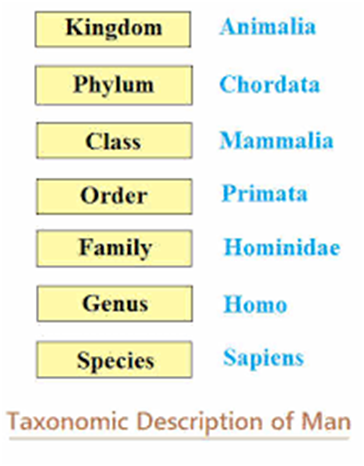

 ACME SMART PUBLICATION
ACME SMART PUBLICATION
